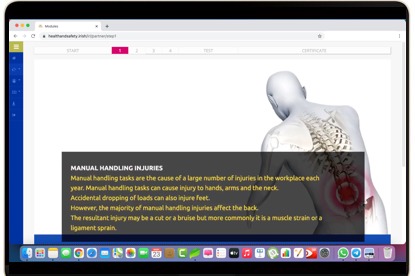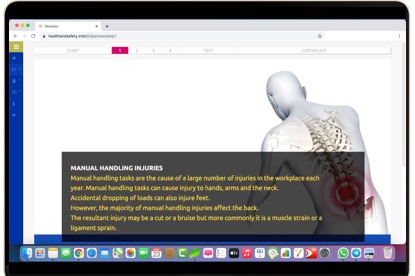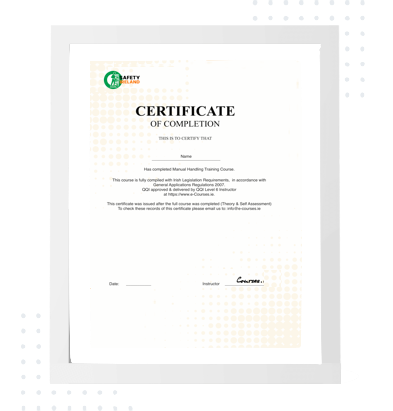















Discounts for bulk purchases:
5€ discount on 10+ courses
10€ discount on 50+ courses







FAQs
I have to carry heavy stuff all the time and I've been fine up until now, surely I don't need the training?
Just because you have been carrying heavy things for a long time, doesn't mean that it is the correct way to do things.
You may have been causing damage to your body without realising. Incorrect manual handling is one of the most common causes of injury at work.
Carrying out this training could result in fewer absences which is beneficial for both the employer and the employee.
Is it the employer or the employee's responsibility to make sure that they are not lifting too much?
All employers have a responsibility to avoid manual handling where possible if there is a risk of injury.
If the lifting cannot be avoided then they should reduce the risk of injury as much as possible.
What is the correct lifting technique?
You should always test the weight of the load before lifting it. Then you should make sure that you are in a stable position.
Always make sure you use your legs, they are your strongest muscles and minimise the pressure on your back.
When lifting from the floor you should, find a stable position, lower to the floor by bending your knees and keeping your back straight, then bring ht load close to your body and use your legs to lift as you stand keep the neutral posture.
What weight can I lift alone?
There are no legal limits of what you can or can't lift at work. But 20kg is about the maximum you should be lifting.
What is the law surrounding manual handling?
The Manual Handling Operations Regulations 1992 is the legislation surrounding manual handling.
It states that if your workplace requires you to do manual handling then everyone one should undertake proper training to understand what the do’s and don'ts of lifting are.
What is a manual handling operation defined as?
The Manual Handling Operations Regulations 1992 defines manual handling as “…any transporting or supporting of a load (including the lifting, putting down, pushing, pulling, carrying or moving thereof) by hand or bodily force.”
How many people a year are injured by manual handling accidents?
Last year, 21% of all non-fatal injuries reported were due to manual handling alone.
Who should undertake risk assessments in the workplace?
It is the employer's responsibility to conduct risk assessments in the workplace.
What is the power zone?
The power zone is the zone between your mid-thigh and mid-chest, where you can lift the most amount of weight with the least amount of exertion.
What are TILE and LITE?
TILE or LITE stands for load, individual, task and environment.
FAQs regarding our Manual Handling course
What legislation is relevant to this course?
The Manual Handling Operations Regulations 1992 is the legislation relevant to this course.
Manual Handling is taken to include the lifting, lowering, pushing, pulling, carrying and movement of anything by hand or bodily force in this.
How long does the course take?
This course takes 30 minutes including the multiple choice test.
What approvals does this course have?
This course is CPID Accredited and IIOSH Approved
What devices is this course available from?
Our courses can be completed on a range of devices, they’re compatible with Desktops, laptops, mobile phones, iPads and other tablets
Why is this training important?
It is important to do this manual handling training as it could help to prevent injuries that are caused by manual handling.
Manual Handling accounts for one-third of all workplace accidents. It is not just for workplaces like warehouses, it is also useful for jobs where small or infrequent lifting tasks may be required.
How long is my certificate valid for?
Certificate valid for 3 years. It is up to the training administrator of the employee as to when training needs to be refreshed.
However, to stay up-to-date with legislation, we recommend that training should be renewed every year.
Our course ends with a multiple choice test to measure your knowledge of the material.
This Manual Handling Training course concludes with a 10 question multiple choice test with a printable certificate.
In addition, brief in-course questionnaires guide the user through the sections of the training and are designed to reinforce
learning and ensure maximum user engagement throughout.
As well as printable user certificates, training progress and results are all stored centrally in your account in our System
and can be accessed any time to reprint certificates, check and set pass marks and act as proof of a commitment
to ongoing legal compliance.
Your Manual Handling Training Certificate includes your name, company name (if applicable),
name of course taken, date of completion, expiry date and stamps of approval or accreditations by recognised authorities.

Our e-learning courses are 100% online, making it easy for you to get the training that you and your company need,
either in your spare time or at work and at any time of day. Bigger orders = better discounts.
The courses have no time limit for completion so you can take full advantage of your training.
Large enterprise orders above 500 courses are dealt with on a case-by-case basis.
This includes a tailor-made package to suit your needs, with some of the following benefits:
To discuss any of your training requirements and budget in more detail, please contact our friendly sales team on +353 89 606 8007.
MINIMISE DISRUPTION - TRAIN ONLINE.
Traditional training methods mean getting all your staff to break off from work and gather in one place. We believe there's a better way...
Training online frees you from the costs and disruption to your business of gathering everyone in a single place to learn.
Online training is accessible 24 hours a day, 7 days a week, 365 days a year; and your progress is automatically saved.
Staff can train from any location or even when commuting.














PLEASE - double check that your name is written correctly.
Once the certificates are issued it will take time,
effort and resources to change the name.